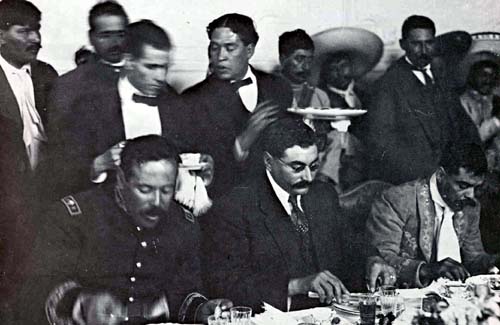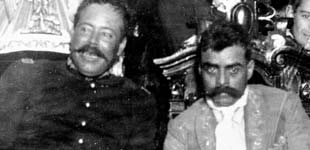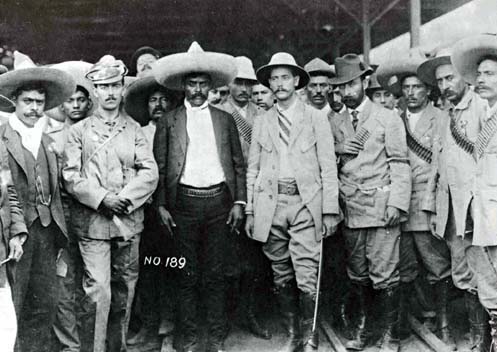<Back to Index>
- Physicist Paul Adrien Maurice Dirac, 1902
- Architect Charles Bulfinch, 1763
- General Emiliano Zapata Salazar, 1879
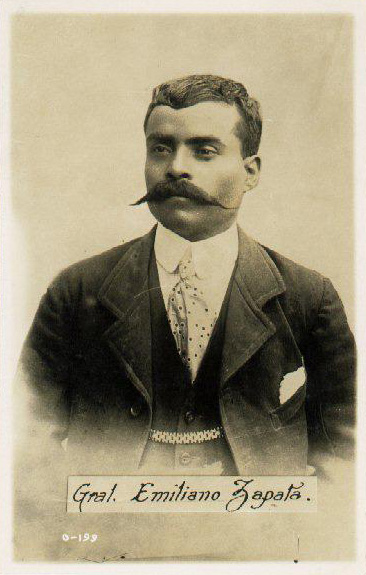
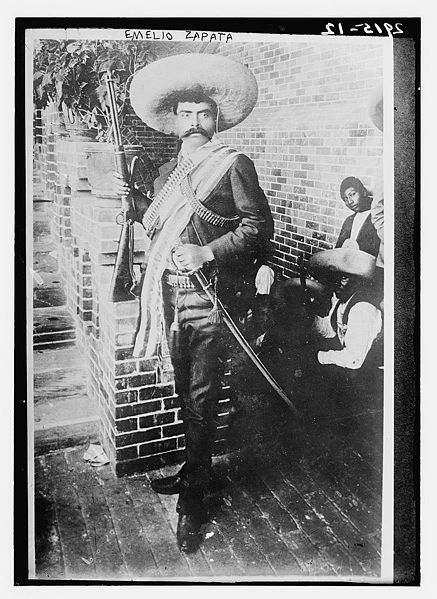
Emiliano Zapata Salazar (August 8, 1879 – April 10, 1919) was a leading figure in the Mexican Revolution, which broke out in 1910, and which was initially directed against the president Porfirio Díaz. He formed and commanded an important revolutionary force, the Liberation Army of the South, during the Mexican Revolution.
Emiliano Zapata was born to Gabriel Zapata, a peasant who trained and sold horses, and Cleofas Salazar in Zacatecas. Zapata's family were Mestizos, being of mixed Nahua and Spanish ancestry; Emiliano was the ninth of ten children. A peasant since childhood, he gained insight into the severe difficulties of the countryside. He received a limited education from his teacher, Emilio Vara. He had to care for his family because his father died when Zapata was 17. Around the turn of the 20th century Anenecuilco was an indigenous Nahuatl speaking community; there exist eyewitness accounts stating that Emiliano Zapata spoke Nahuatl fluently.
At that time, Mexico was ruled by Porfirio Díaz, who rose to power in 1876. The social system of the time was a sort of proto-capitalist feudal system, with large landed estates (haciendas) controlling more and more of the land and squeezing out the independent communities of the indigenous who were subsequently forced into debt slavery (peonaje) on the haciendas. Díaz ran local elections to pacify the people and run a government that they could argue was self-imposed. Under Díaz, close confidants and associates were given offices in districts throughout Mexico. These officials became enforcers of "land reforms" that drove the haciendas into the hands of progressively fewer and wealthier landowners.
Zapata came from a middle class family who were able to avoid peonage and to maintain their own land (rancho). In fact, the family had been porfiristas: supporters of Porfirio Díaz. Zapata had the reputation of a dandy, appearing at bullfights and rodeos in his elaborate charro (cowboy) outfit. In 1906, he attended a meeting in Cuautla to discuss a way to defend the land of the people, on which he had worked as a farmhand. In 1908, due to his first acts of rebellion, he was drafted into the Ninth Regiment and sent to Cuernavaca. However, because of his skill with horses, he remained a soldier for only six months. At the request of Ignacio de la Torre, who employed him as a groom, he left for Mexico City. Though his gaudy attire might have suggested an affiliation with the rich hacendados who controlled the lands, he retained the admiration of the people of his village, Anenecuilco.
In
1909 an important meeting was called by the elders of Anenecuilco. At
that time, José Merino was the chief elder of the village and
was well respected by all. He called the meeting to publicly resign
from his position due to his old age and limited abilities to continue
the fight for the land rights of the village. The meeting was used as a
time for discussion and nomination of individuals as a replacement for
Merino as the president of the village council. The elders on the
council were so well respected by the village men that no one would
dare to override their nominations or overtake the vote for an
individual against the advice of the current council. The nominations
made were: Modesto Gonzales, Bartolo Parral, and Emiliano Zapata. After
the completion of nominations, a vote was taken and Zapata became the
new council president without contest. Although
Zapata had turned 30 only a month before, the voters knew that it was
necessary to elect an individual who would be responsible for the
village and who was well respected by the village people. Even though
he was young, the village was ready to hand over the controlling force
to him without any worry of failure. Before he was elected he had shown
the village his nature by helping to head up a campaign in opposition
to a candidate for governor. Even though his efforts and his cause
failed greatly, he was able to create and cultivate relationships with
political authority figures that would prove useful for him.
Zapata
became a leading figure in the village of Anenecuilco, where his family
had lived for many generations, and he became involved in struggles for
the rights of the campesinos of
Morelos. He was able to oversee the redistribution of the land from
some haciendas peacefully, but had problems with others. He observed
numerous conflicts between villagers and hacendados, or landowners, over the constant theft of village land, and in one instance, saw the hacendados torch an entire village. For many years, he campaigned steadfastly for the rights of the villagers, first establishing via ancient title deeds their
claims to disputed land, and then pressing the recalcitrant governor of
Morelos into action. Finally, disgusted with the slow response from the
government and the overt bias towards the wealthy plantation owners,
Zapata began making use of armed force, simply taking over the land in
dispute. At this time, Porfirio Díaz was being threatened by the candidacy of Francisco I. Madero.
Zapata made quiet alliances with Madero, whom he perceived to be the
best chance for genuine change in the country. In 1910, Zapata quickly
took an important role, becoming the general of an army that formed in Morelos – the Ejército Libertador del Sur (Liberation Army of the South). Zapata joined Madero’s campaign against President Diaz. With the support of Pancho Villa, Pascual Orozco, Emiliano Zapata, and rebellious peasants, Madero overthrew Díaz in May 1911 in the battle at Ciudad Juárez. A provisional government was formed under Francisco León de la Barra.
Under Madero, some new land reforms were carried out and elections were
to be ensured. However, Zapata was dissatisfied with Madero's stance on
land reform, and was unable, despite repeated efforts, to make him
understand the importance of the issue or to get him to act on it. Madero
was not ready to create a radical change in the manner that agrarian
relations operated during this time. Some other individuals, called
"anarcho-syndicalist agitators", had made promises to take things back
to the way that they had been done previously. The major method of
agrarian relations had been that of communal lands, called "ejidos".
Although some believed that this could be the best course of action,
Madero simply demanded that "Public servants act 'morally' in enforcing
the law...". Upon seeing the response by villagers, Madero offered
formal justice in courts to individuals who had been wronged by others
with regard to agrarian politics. Zapata decided that on the surface it
seemed as though Madero was doing good things for the people of Mexico,
but Zapata did not know the level of sincerity in Madero's actions and
thus did not know if he should support him completely. Madero
and Zapata's relations worsened during the summer of 1911 as Madero
appointed a governor who supported plantation owners and refused to
meet Zapata’s agrarian goals. Compromises between the two failed in
November 1911, days after Madero appointed himself President, and
Zapata and Montaño fled to the mountains of southwest Puebla. There they formed the most radical reform plan in Mexico; the Plan de Ayala. Zapata was partly influenced by an anarchist from Oaxaca named Ricardo Flores Magón. The influence of Flores Magón on Zapata can be seen in the Zapatistas' Plan de Ayala, but even more noticeably in their slogan (this slogan was never used by Zapata) "Tierra y libertad"
or "land and liberty", the title and maxim of Flores Magón's
most famous work. Zapata's introduction to anarchism came via a local
schoolteacher, Otilio Montaño Sánchez – later a general
in Zapata's army, executed on 17 May 1917 – who exposed Zapata to the
works of Peter Kropotkin and
Flores Magón at the same time as Zapata was observing and
beginning to participate in the struggles of the peasants for the land. The
plan proclaimed the Zapatista demands for "Reforma, Libertad Ley y
Justicia" (Reform, Freedom, Law and justice) Zapata also declared the
Maderistas as a counter-revolution and denounced Madero. Zapata mobilized his Liberation Army and allied with former Maderistas Pascual Orozco and Emiliano Vázquez Gómez. Orozco was from Chihuahua, near the U.S. border, and thus was able to aid the Zapatistas with a supply of arms. In the following weeks, the development of military operations "betray(ed) good evidence of clear and intelligent planning." In
the original design of the armed force, Zapata was a mere colonel among
several others. However, the true plan that came about through this
organization lent itself to Zapata. Zapata believed that the best route
of attack would be to center the fighting and action in Cuautla. If
this political location could be overthrown, the army would have enough
power to "veto anyone else's control of the state, negotiate for
Cuernavaca or attack it directly, and maintain independent access to
Mexico City as well as escape routes to the southern hills." However, in order to gain this great success, Zapata realized that his men needed to be better armed and trained. The first line of action demanded that Zapata and his men "control the area behind and below a line from Jojutla to Yecapixtla." When
this was accomplished it gave the army the ability to complete raids as
well as wait. As the opposition of the federal army and police
detachments slowly dissipated, the army would be able to eventually
gain powerful control over key locations in the Interoceanic Railway from
Puebla City to Cuautla. If these feats could be completed, it would
gain access to Cuautla directly and the city would fall. The
plan of action was carried out and saw amazing success in Jojutla.
However, Torres Burgos, the commander of the operation, did not
understand how the army could have disobeyed his orders against looting
and ransacking. The army took complete control of the area and it
seemed as though Torres Burgos lost any type of control that he
believed he had over his forces prior to this event. Shortly after,
Burgos called a meeting and resigned from his position. Upon leaving
Jojutla with his two sons, Burgos was surprised by a federal police
patrol who subsequently shot all three of the men on the spot. This
seemed to some to be an ending blow to the movement because Burgos had
not selected a successor for his position; however, Zapata was ready to
take up where Burgos had left off. Shortly
after Burgos' death a party of rebels elected Zapata as "Supreme Chief
of the Revolutionary Movement of the South". This
seemed to be the fix to all of the problems that had just arisen, but
other individuals wanted to replace Zapata as well. Due to this new
conflict, the individual who would come out on top would have to do so
by "convincing his peers he deserved their backing". Zapata finally did gain the support necessary by his peers and was considered a "singularly qualified candidate".
This decision to make Zapata the true leader of the revolution did not
occur all at once, nor did it ever reach a true definitive level of
recognition. In order to succeed, Zapata needed a strong financial
backing for the battles to come. This came in the form of 10,000 pesos
delivered by Rodolfo from the Tacubayans. Due to this amazing sum of money Zapata's group of rebels became one of the strongest in the state financially. After some time Zapata became the leader of his "strategic zone." This
gave him tremendous power and control over the actions of many more
individual rebel groups and thus increased his margin of success
greatly. "Among revolutionaries in other districts of the state,
however, Zapata's authority was more tenuous." After
a meeting with Zapata and Ambrosio Figueroa in Jolalpan, it was decided
that Zapata would have joint power with Figueroa with regard to
operations in Morelos. This
was a turning point in the level of authority and influence that Zapata
had gained and proved useful in the direct overthrow of Morelos. Zapata
immediately began to use his newly-found power and began to overthrow
city after city with gaining momentum. Madero, alarmed, asked Zapata to
disarm and demobilize. Zapata responded that, if the people could not
win their rights now, when they were armed, they would have no chance
once they were unarmed and helpless. Madero sent several generals in an
attempt to deal with Zapata, but these efforts had little success. It
seemed as though Zapata would shortly be able to overthrow Morelos, but
then the Treaty of Ciudad Juarez was signed. This officially and formally ended the civil war. Although
this may have caused individuals to believe that the revolution was
over, it was not. The battle continued for years to come over the fact
that Mexican individuals did not have agrarian rights that were fair,
nor did they have the protection necessary to fight against those who
pushed such exploitation upon them. Although
government forces could never completely defeat Zapata in battle, in
1919, he fell victim to a carefully staged ambush by Gen. Pablo González and his lieutenant, Col. Jesús Guajardo who were supporters of the Mexican president, Venustiano Carranza.
Guajardo proposed González feign a defection to Zapata's forces.
González agreed, and to make the defection appear sincere, he
arranged for Guajardo to attack a Federal column, killing 57 soldiers.
Zapata subsequently agreed to receive a messenger from Guajardo, to
arrange a meeting to speak about Guajardo's defection. On
April 10, 1919, Guajardo invited Zapata to a meeting, intimating that
he intended to defect to the revolutionaries. However, when Zapata
arrived at the Hacienda de San Juan, in Chinameca, Ayala municipality, Guajardo's men riddled him with bullets. They then took his body to Cuautlato to claim the bounty, where they are reputed to have been given only half of what was promised. Following Zapata's death, the Liberation Army of the South slowly fell apart, although Zapata'sheir apparent Gildardo Magaña and
many other Zapata adherents went on to political careers as
representatives of Zapatista causes and positions in the Mexican army
and government. Some of his former generals like Genovevo de la O allied with Obregón while others eventually disappeared after Carranza was deposed.
